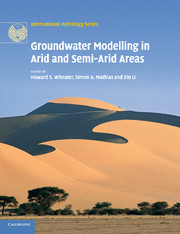Book contents
- Frontmatter
- Contents
- Contributors
- Preface
- Acknowledgements
- 1 Groundwater modelling in arid and semi-arid areas: an introduction
- 2 Hydrological processes, groundwater recharge and surface-water/groundwater interactions in arid and semi-arid areas
- 3 Conceptual models for recharge sequences in arid and semi-arid regions using isotopic and geochemical methods
- 4 Groundwater flow and transport
- 5 Performing unbiased groundwater modelling: application of the theory of regionalised variables
- 6 Groundwater vulnerability and protection
- 7 Variable density groundwater flow: from modelling to applications
- 8 Sustainable water management in arid and semi-arid regions
- Index
- Plate section
- References
2 - Hydrological processes, groundwater recharge and surface-water/groundwater interactions in arid and semi-arid areas
Published online by Cambridge University Press: 06 December 2010
- Frontmatter
- Contents
- Contributors
- Preface
- Acknowledgements
- 1 Groundwater modelling in arid and semi-arid areas: an introduction
- 2 Hydrological processes, groundwater recharge and surface-water/groundwater interactions in arid and semi-arid areas
- 3 Conceptual models for recharge sequences in arid and semi-arid regions using isotopic and geochemical methods
- 4 Groundwater flow and transport
- 5 Performing unbiased groundwater modelling: application of the theory of regionalised variables
- 6 Groundwater vulnerability and protection
- 7 Variable density groundwater flow: from modelling to applications
- 8 Sustainable water management in arid and semi-arid regions
- Index
- Plate section
- References
Summary
GROUNDWATER RESOURCES, GROUNDWATER MODELLING AND THE QUANTIFICATION OF RECHARGE
The traditional development of water resources in arid areas has relied heavily on the use of groundwater. Groundwater uses natural storage, is spatially distributed and, in climates where potential evaporation rates can be of the order of metres per year, provides protection from the high evaporation losses experienced by surface-water systems. Traditional methods for the exploitation of groundwater have been varied, including the use of very shallow groundwater in seasonally replenished riverbed aquifers (as in the sand rivers of Botswana), the channelling of unconfined alluvial groundwater in afalaj (or qanats) in Oman and Iran, and the use of hand-dug wells. Historically, abstraction rates were limited by the available technology, and rates of development were low, so that exploitation was generally sustainable.
However, in recent decades, pump capacities have dramatically increased and hence agricultural use of water has grown rapidly, while the increasing concentration of populations in urban areas has meant that large-scale well fields have been developed for urban water supply. A common picture in arid areas is that groundwater levels are in rapid decline; in many instances this is accompanied by decreasing water quality, particularly in coastal aquifers where saline intrusion is a threat. Associated with population growth, economic development and increased agricultural intensification, pollution has also become an increasing problem. The integrated assessment and management of groundwater resources is essential so that aquifer systems can be protected from pollution and over-exploitation.
- Type
- Chapter
- Information
- Groundwater Modelling in Arid and Semi-Arid Areas , pp. 5 - 20Publisher: Cambridge University PressPrint publication year: 2010
References
- 2
- Cited by



